Actress Janet Leigh's third husband was actor Tony Curtis. Their
daughter's are actresses Kelly Curtis and 1980's Horror star Jamie Lee Curtis. Janet Leigh appears to be remembered mainly for one motion picture from director Alfred
Hitchcock. This is a look at that motion picture and four others. One is a classic and Very Dark
Film Noir. Another a classic Political thriller and two are pure Horror movies starring her daughter Jamie
Lee Curtis.

Over her career Merced, California born Jeanette Helen Morrison appeared in Comedies, Musicals, Drama, Westerns and Horror motion pictures. Examples of her work include 1949's "Words and Music" starring Mickey Rooney and June Allyson. Janet Leigh was billed 2nd in Western director Anthony Mann's 1953 "The Naked Spur" between James Stewart and Robert Ryan. Leigh co-starred with her, then, husband Tony Curtis in several feature films. Two of them were producer George Pal's 1954's "Houdini" and Universal Studio's first CinemaScope motion picture 1955's "The Black Shield of Falworth". The actress was in Howard Hughes' 1957 "Jet Pilot" with John Wayne and the movie version of the Broadway musical "Bye Bye Birdie" in 1963 with Dick Van Dyke and Ann-Margaret.
On television Janet Leigh appeared on such programs as 1964's "Bob Hope Presents the Chrysler Theatre", 1966's "The Man from U.N.C.L.E.", the same years "The Red Skelton Hour", 1978's "The Love Boat" and an episode of 1989's "The Twilight Zone".
That Very Dark Film Noir was:
TOUCH OF EVIL released March 30, 1958
"Touch of Evil" would be overshadowed for Janet Leigh by the still very good historical adventure "The Vikings", released June 11, 1958, and co-starring Kirk Douglas, Tony Curtis and Ernest Borgnine. In fact "Touch of Evil" would remain practically an unknown motion picture over the years except to the Orson Wells fan base and film historians.

Over her career Merced, California born Jeanette Helen Morrison appeared in Comedies, Musicals, Drama, Westerns and Horror motion pictures. Examples of her work include 1949's "Words and Music" starring Mickey Rooney and June Allyson. Janet Leigh was billed 2nd in Western director Anthony Mann's 1953 "The Naked Spur" between James Stewart and Robert Ryan. Leigh co-starred with her, then, husband Tony Curtis in several feature films. Two of them were producer George Pal's 1954's "Houdini" and Universal Studio's first CinemaScope motion picture 1955's "The Black Shield of Falworth". The actress was in Howard Hughes' 1957 "Jet Pilot" with John Wayne and the movie version of the Broadway musical "Bye Bye Birdie" in 1963 with Dick Van Dyke and Ann-Margaret.
On television Janet Leigh appeared on such programs as 1964's "Bob Hope Presents the Chrysler Theatre", 1966's "The Man from U.N.C.L.E.", the same years "The Red Skelton Hour", 1978's "The Love Boat" and an episode of 1989's "The Twilight Zone".
That Very Dark Film Noir was:
TOUCH OF EVIL released March 30, 1958
"Touch of Evil" would be overshadowed for Janet Leigh by the still very good historical adventure "The Vikings", released June 11, 1958, and co-starring Kirk Douglas, Tony Curtis and Ernest Borgnine. In fact "Touch of Evil" would remain practically an unknown motion picture over the years except to the Orson Wells fan base and film historians.
Initially Universal Studios was looking for a vehicle for actor
Charlton Heston. Heston refused to sign a contract unless he knew who was to
direct. According to the actor Orson Welles had only signed a contract to act in the still unscripted property, but agreed, for more money, to direct the film. Once Welles was signed the studio was able to get Charlton Heston to sign also. That was one story.
Another story states that after Orson Welles acted in producer Albert Zugsmith 1957 modern setting Western "Man in the Shadow" starring
Jeff Chandler. Welles was so awed by the producer that he wanted to direct a future film for Zugsmith. According to this story the producer
handed Orson Welles some scripts to consider.
Neither story sounds true, but this was Hollywood. What is true is that Orson Welles not
only co-starred and directed, but wrote the screenplay for "Touch of
Evil". Considered one of the last of the Film Noirs from
the "Classic Period" of the 1940's and 1950's.
The screenplay is credited to the 1956 novel "Badge
of Evil" by White Masterson. Actually writers Robert Allison
"Bob" Wade and H. Bill Miller.
The plot of "Badge of Evil" is set
entirely in San Diego, California. It starts with a man named "Rudy
Linneker" being blown up with his house. Police Detectives "Leron
McCoy" and "Hank Quinlan", who has an injured leg and uses a
cane, are assigned to investigate. While Assistant District Attorney "Mitch
Holt" is given the job to prosecute the person, or persons who are behind
the murder. Initially "Linneker's" daughter "Tara" and her
fiance "Delmont Shayon" are suspects, but they're cleared.
As the story progresses "Holt" becomes suspicious of a
confession for the murder by "Linneker's" disgruntled employee "Ernest Farnum".
The confession and the evidence seem too pat as dynamite has been found in a
shoe box in Farnum's apartment not very well concealed. "Holt" loops in the "District Attorney
Adair" and "Police Chief Pete Gould". Afterwards, at his home,
"Mitch Holt" is shot at by a mysterious gunman. "Holt's"
case seems to be pointing toward Detective "McCoy" for planting the
evidence and possibly taking the shot at him. "Mitch" searches the
public records looking at the past cases of "McCoy" and
"Quinlan". He finds a pattern to them similar to
"Linneker's" murder. All leading to promotions, or other recognition for both Detectives.
For their safety "Holt" sends his wife
"Consuelo" and daughter "Nancy" to live with his
father-in-law in Mexico. However, his wife returns just as "Mitch"
gets a local newspaper to make his accusations public, because the D.A. doesn't
believe them. Next "Consuelo" is kidnapped, taken to a hotel,
drugged and framed for possession of narcotics and jailed. She is obviously
being used as a means of stopping "Mitch Holt's" investigation.
Additionally, "Holt" is removed from his office over his actions in
the case and the fact his wife is a drug addict that can compromise him.
"Quinlan" confesses to "Holt" and carries a
wire to a meeting with "McCoy". "McCoy" reveals he was the
original killer, he planted the evidence and threatened the employee who
confessed to the murder. He also admits drugging "Consuela". All to
get even with "Mitch Holt" over an incident in their past. While
"McCoy" is telling his story and "Holt" is recording.
"McCoy" and "Quinlan" get into an argument and the former
kills the later. With his tape recording "Holt" is able to get his
wife released from jail, his old job back. To avoid prosecution and jail "Quinlan" committes suicide.
I will not get into the Orson Wells screen play for "Touch
of Evil" at this point. Other than to say only four named
characters from the novel remain and each is changed from their original descriptions. Especially "Hank
Quinlan".
The main cast of characters were portrayed by some fine 1940's and
1950's actors and actresses:
Charlton Heston is Mexican Drug Enforcement Official "Ramon
Miguel 'Mike' Vargas" in a heavy Hispanic make-up.


Janet Leigh is his American wife "Susan 'Susie' Vargas".
Orson Welles in now American "Police Captain Hank
Quinlan". Also in 1958 he had appeared in author William Faulkner's "The Long Hot Summer" with Paul Newman and Joanne Woodward. Two years earlier he had a small role in director John Huston's version of Herman Melville's "Moby Dick"

Joseph "Joe" Calleia is "Pete Menzies" as the
Police partner of "Quinlan". There is no character like "Leron
McCoy" in the screenplay. "Pete" idolizes "Hank". Calleia had been acting since 1931. Some of his work included 1939's "Juarez" starring Paul Muni and Bette Davis, 1943's "For Whom the Bell Tolls" starring Gary Cooper and Ingrid Bergman, 1946's "Gilda" starring Rita Hayworth and Glenn Ford and 1955's "Underwater" starring Jane Russell and Gilbert Roland.


Akim Tamiroff is gangster "Uncle' Joe Grandi. Character actor Akim Tamiroff was in 157 motion pictures and television shows over his career. These included Cecil B. DeMille's 1938 "The Buccaneer" starring Frederick March, DeMille's 1939 "Union Pacific" starring Barbara Stanwyck and Joel McCrea, the aforementioned 1943 "For Whom the Bell Tolls", 1949's "Black Magic" starring Orson Welles and later he was in the original 1960 "Ocean's 11" starring Frank Sinatra and his "Rat Pack".


Marlene Dietrich was brothel owner "Tanya". Immediately before this picture she appeared in directer Billy Wilder's 1957 "Witness for the Prosecution" starring Tyrone Power and Charles Laughton. Immediately after this picture she appeared in Stanley Kramer's 1961 epic "Judgement at Nuremberg". Of course she was in the 1939 Western "Destry Rides Again" and 1942's "Pittsburgh" co-starring Randolph Scott and John Wayne.

Ray Collins was "District Attorney Adair", below left, and on
the right, in glasses, is Mort Mills as "District Attorney Assistant Al
Swartz". Collins was in both 1941's "Citizen Kane" starring and directed by Orson Welles, but 1950's television viewers knew him as "Lieutenant Tragg" on the Raymond Burr series "Perry Mason". More on Mort Mills later.

Dennis Weaver was the "Mirador Motel Night Manager". Weaver had appeared on television's "Dragnet" from 1954 through 1955 and would be "Chester" on "Gunsmoke" between 1955 and 1954. Although he appeared in motion pictures during this time mostly Westerns for Universal Pictures.

Zsa Zsa Gabor was the "Strip Club Owner". Gabor was appearing mainly on television, but in 1952 had co-starred with Jose Ferrer in director John Huston's "Moulin Rouge". The same year as this film she appeared, not as the title character, in the Cult Science Fiction movie "Queen of Outer Space" as a Venusian Scientist in love with Earth man Eric Fleming.

Valentin de Vargas portrayed "Pancho Sanchez". His first role was a "Latin Student" in Glenn Ford's 1955 "Blackboard Jungle". Valentin basically was appearing on television Westerns, but would be seen in 1960's "The Magnificent Seven". In 1962 he was "Luis" in the Howard Hawks movie "Hatari" starring John Wayne.

Also in the cast without on screen credit were Joseph Cotton as a
"Coroner", Eva Gabor as a "Stripper", Academy Award Winning Actress Mercedes McCambridge
as a "Gang Leader" and Keenan Wynn as a "Bartender".
An important element to both
the screenplay and direction by Orson Welles is the black and white
Cinematography of Russell Metty. Metty had been in the profession since 1934
and would win the Academy Award for Stanley Kubrick's 1960 "Spartacus".
A Summary of the Orson Welles Screenplay:
The obvious changes are with some of the characters names and moving
the novel's plot from San Diego to an unnamed Mexican town somewhere on the
Southern border. Additionally there is a subtle racial tone to the screenplay.
From a pure cinematic perspective "Touch of
Evil" is still recommended to film students for the opening
sequence. In what is a three minute and 20 second long single dolly tracking
shot. The audience first sees a Time Bomb planted in a car on the Mexico side of the border and the cars movements.


The characters as written and presented by Orson Welles are typical for Film Noir. Not
one is likable and are all "Seedy" in their nature. With the single
exception of "Susan Vargas" and her nature changes as the film
progresses.
Wells still uses "Rudy Linnekar" as the murder victim, but he now has a girlfriend named "Zita". The audience sees both enter the car with the bomb and start driving toward the border crossing.

Wells still uses "Rudy Linnekar" as the murder victim, but he now has a girlfriend named "Zita". The audience sees both enter the car with the bomb and start driving toward the border crossing.

"Zita" makes a comment that there's something ticking in the car. As they continue to drive toward the border crossing the audience sees Mexican Drug
Enforcement Officer "Ramon Miguel Vargas" and his new bride
"Susan" walk by the car several times as the three keep intersecting.
The car crosses into the United States and explodes killing both
passengers.
"Vargas" immediately becomes concerned not for the two people who were killed, but the fact two American citizens were killed by a Mexican planted bomb. When he arrives at the scene of the explosion. So does Police Chief "Pete Gould", District Attorney
"Adair" and eventually Police Captain "Hank Quinlan" and
Officer "Pete Menzies".
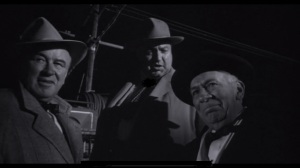
Crossing the border "Hank Quinlan" visits the brothel
run by "Tanya". The madam makes a comment upon how obese
"Hank" has become since they last saw each other. This was an inside
"joke" by Welles about himself and his major weight increase in 1953.
"Quinlan" and "Menzies" prime suspect is a
young Mexican hood named "Pancho Sanchez". Who happens to be secretly
married to "Rudy Linnekar's" daughter "Marcia Linnekar".
"Mike Vargas" accompanies the two detectives to "Sanchez's"
apartment to interrogate him. While this is happening "Vargas" goes
into the bathroom and accidentally knocks over an empty shoe box. This is
immediately followed by "Menzies" entering the bathroom and telling
the other man that two sticks of dynamite were found in that shoe box.
"Mike Vargas" suspects that "Hank Quinlan" is planting
evidence to get a quick conviction and close the case.
"Quinlan" dismisses "Vargas" saying he's
obviously biased in favor of fellow Mexicans. The accusations being made by
"Mike Vargas" bother "Hank Quinlan" and added pressure comes from Mob Boss "Uncle' Joe
Grandi". Apparently "Vargas" is investigating
"Grandi's" brother and "Uncle Joe" wants
"Hank" to do something about it. As a result after 12 years of being
sober "Hank Quinlan" returns to the bottle.


Meanwhile, with the help of Assistant D.A. "Al
Schwartz". Mexican Drug Enforcement Officer "Miguel Vargas" is
looking at records of "Hank Quinlan's" previous cases.

Both men speak to "Gould" and "Adair" and
"Quinlan" overhears them and threatens to resign. While by her hotel "Pancho
Sanchez" terrorizes "Susie Vargas" per "Uncle Joe".
After this happens she decides to move from
the Mexican motel, she and her husband were staying at, to a remote American
motel recommended by "Pete Menzies" to avoid the attention of
"Grandi" and "Sanchez". "Susie Vargas" is unaware that "Uncle
Joe" had been attempting to pressure her husband, but also that the motel is
actually owned by mobster. Working for the mobster is a very unsettling Night Motel Manager who is frightened of "Sanchez" and his gang.
After "Susan Vargas" has phoned her husband about the move to the American motel. "Pancho Sanchez" and his gang
show up on "Grandi's" orders to once more terrorize her.


"Mike" attempts to call his wife, but his call is being
blocked my the Night Manager. "Hank Quinlan" goes to the motel and working with
"Grandi" arranges for the kidnapping of "Susie". She's
taken to "Joe Grandi" and "Captain Quinlan" is also present. He knocks her unconscious and then, after "Sanchez" and his gang have left, kills the mobster. Next "Quinlan" places drugs around the room to give
the appearance that in a drug induced state "Susan Vargas" murdered
"Uncle Joe Grandi".
"Susie Vargas" wakes up to see the
"Grandi's" body, screams, bringing people and is arrested on suspicion of a murder she can't explain.


"Vargas" confront "Menzies" about the history
of the evidence he has found on "Captain Quinlan". "Menzies"
reveals to "Vargas" that he found "Quinlan's" cane at the
murder scene. A mistake "Captain Quinlan" made.
"Miguel Vargas" fits "Pete Menzies" with a wire. While "Quinlan" goes to "Tanya's" brothel for a tarot card reading, but he hears what he doesn't want to know. According to "Tanya". "Quinlan" has no future.

"Menzies" and "Quinlan" go to the nearby oil
field being followed by "Vargas" taping their conversation.
"Hank" admits to "Pete" that he has been planting evidence
on people, but only because they were guilty.
Then "Quinlan" hears an echo from the microphone. He tells "Menzies" that his "Game Leg" has told him
"Pete" has betrayed him and demands to see "Vargas". "Captain Quinlan" than shoots and kills "Menzies" with a gun he had stolen from "Miguel Vargas". Next he prepares to kill the Drug Officer using the others own gun, but
is shot, himself, by the dying "Menzies".
"Quinlan" staggers backwards and dies in a pool of waste
water. "Al Schwartz" arrives and tells "Officer Varas" that
"Pancho Sanchez" confessed to planting the bomb. "Susan
Vargas" is being released from prison.
"Tanya" comes to the oil field and "Al" asks her what she had to say
about "Hank Quinlan". She replies:
He was some kind of a man. What does it matter what you say about people?
The movie fades out as "Tanya" walks away.

Orson Welles' "Touch of Evil" is often compared, by
film critics and historians, to Alfred Hitchcock's "Psycho", because
of many similarities in the two films. In his October 4, 2004
obituary for Janet Leigh. Writer Michael Muskal quoted the actress, from an
earlier interview, on "Touch of Evil":
Universal just couldn't understand it, so they recut it. Gone was the undisciplined but brilliant film Orson had made.
Relating to Leigh's
above quote. The 1958 release of "Touch of Evil" was
re-edited, on the orders of Executives at Universal Pictures, from Orson Welles'
original cut for General release at 93 minutes. That release is confusing for any viewer.
In 1976 the film was re-edited by adding found footage cut by Universal and now ran 108 minutes. but it still wasn't the film Welles had made. In 1998 there was a third re-edit based upon Orson Welles' notes and his original screenplay. The released film now had a running time of 111 minutes, but it is agreed that even that version is not what Orson Welles had originally wanted released.
What that original "Director's Cut" looked like is unknown and more edited out footage from 1958 could not be located, but 1998 is the closest version to the Film Noir Orson Welles created. After a confusing lawsuit attempting to block that release. It received the endorsement of his Estate. All three versions can be found on the current Blu-Ray release.
PSYCHO premiered at the DeMille Theatre in New York on June 16, 1960
In 1976 the film was re-edited by adding found footage cut by Universal and now ran 108 minutes. but it still wasn't the film Welles had made. In 1998 there was a third re-edit based upon Orson Welles' notes and his original screenplay. The released film now had a running time of 111 minutes, but it is agreed that even that version is not what Orson Welles had originally wanted released.
What that original "Director's Cut" looked like is unknown and more edited out footage from 1958 could not be located, but 1998 is the closest version to the Film Noir Orson Welles created. After a confusing lawsuit attempting to block that release. It received the endorsement of his Estate. All three versions can be found on the current Blu-Ray release.
PSYCHO premiered at the DeMille Theatre in New York on June 16, 1960

The General Release of "Psycho" was on September 8, 1960. At the time I was 13 years old and went to the Majestic Theatre, now a legitimate stage and concert venue, on what became the Santa Monica, California, 3rd Street Promenade, What kept that showing in my memory was the movie theater's manager coming down in front of the screen to warn all of the young audience, there was no age restriction on the picture, to keep quiet and not to be running up and down the aisles to ruin the other patrons enjoyment. He also added that it was his belief that Alfred Hitchcock's "Psycho" was too adult for our viewing.
Ask somebody who was in Alfred Hitchcock's Psycho" and you will usually get a reply of Janet Leigh and Anthony Perkins. What is interesting is that the motion picture runs 109 minutes, but Janet Leigh is "cut out" after only 23 minutes and 22 seconds. Yet, the famous shower scene has become a Horror movie Iconic sequence, but is "Psycho" really a "Horror Movie" in the true sense? I leave that answer to my reader.
The screenplay was by Joseph Stefano. When Alfred Hitchcock hired Stefano to write the screenplay. He only had five writing credits and four of those were for episodes of television shows. His first on screen credit had been the crime drama 1958's "The Black Orchid" starring Sophia Loren and Anthony Quinn.
Joseph Stefano's screenplay was based upon Robert Bloch's 1959 novel "Psycho". The author did not work on the screenplay, but would write screenplays for television and motion pictures starting in 1961.
Boch's television work included three television anthology series: "Alfred Hitchcock Presents", "The Alfred Hitchcock Hour" and "Thriller". Which was hosted by Boris Kalroff.
Robert Boch's motion picture screenplays included the 1962 version of the classic German silent "The Cabinet of Caligari" and in 1964, for William Castle, both "Strait-Jacket" and "The Night Walker". Robert Boch created and was primary writer for the 2013 television series "The Bates Motel".
Changes to Robert Boch's "Norman Bates" was made to the screenplay. Partly because of the statue of Anthony Perkins compared to the novel's "Norman". Who was overweight and heavily drank bringing out the "Mother Personality". "Norman" also engaged in Spiritualism, the Occult and Pornography. Hitchcock and Stefano also changed the novels beginning of "Norman Bates' reading a history book and "Marian's" arrival. Instead they open with "Marian's" back story to grab the audience. Which brings me to the films cast.
Going in screen credit billing order for the four leading actors are:
Anthony Perkins was "Norman
Bates". This was Perkins 21st on screen appearance. Which initially included 9
television shows before this film. His motion pictures included
1956's "Friendly Persuasion" starring Gary Cooper
and Dorothy McGuire, 1957's "Fear
Strikes Out"the story of Baseball's Jim Piersall, the same years Western "The Tin
Star" starring Henry Fonda and 1959's apocalyptic "On
the Beach" starring Gregory Peck, Ava Gardner and Fred Astaire,
Right before "Psycho" Perkins co-starred with Jane
Fonda in the Romantic Comedy 1960's "Tall Story".

Vera Miles was "Lila Crane". Among Miles work prior to this feature were John Ford's 1956 classic Western "The Searchers". Miles was the girl Jeffrey Hunter is in love with. She played the wife of Henry Fonda in Alfred Hitchcock's 1956 "The Wrong Man" and James Stewart's wife in 1959's "The FBI Story". She would play Stewart's wife, again, in John Ford's 1962 Western "The Man Who Shot Liberty Valance".

John Gavin was "Sam Loomis". Gavin was a 1950's/1960's leading man. He co-starred with Lana Turner and Sandra Dee in the 1959 version of the Fannie Hurst novel "Imitation of Life". After this picture he would co-star with Dee in 1961's "Romanoff and Juliet" and "Tammy Tell Me True". The same year of this picture John Gavin portrayed the young "Julius Caesar" in Stanley Kubrick's "Spartacus".


Vera Miles was "Lila Crane". Among Miles work prior to this feature were John Ford's 1956 classic Western "The Searchers". Miles was the girl Jeffrey Hunter is in love with. She played the wife of Henry Fonda in Alfred Hitchcock's 1956 "The Wrong Man" and James Stewart's wife in 1959's "The FBI Story". She would play Stewart's wife, again, in John Ford's 1962 Western "The Man Who Shot Liberty Valance".

John Gavin was "Sam Loomis". Gavin was a 1950's/1960's leading man. He co-starred with Lana Turner and Sandra Dee in the 1959 version of the Fannie Hurst novel "Imitation of Life". After this picture he would co-star with Dee in 1961's "Romanoff and Juliet" and "Tammy Tell Me True". The same year of this picture John Gavin portrayed the young "Julius Caesar" in Stanley Kubrick's "Spartacus".
Above John Gavin and Vera Miles.
Janet Leigh was "Marion Crane".

The Two Co-Stars:
Martin Balsam was "Detective Milton Arbogast". At this time Balsam was basically a television actor, but did appear in three motion pictures. They were 1957's "12 Angry Men" starring Henry Fonda, 1958's "Majorie Morningstar" starring Natalie Wood and Gene Kelly, and 1959's "Al Capone" starring Rod Steiger in the title role.

John McIntyre was "Sheriff Al Chambers". Character actor McIntyre had been acting since 1940. In 1959 he became known for taking over as the "Wagon Train Boss" for the late Ward Bond on television's "Wagon Train". Right after "Psycho" he was featured in the Burt Lancaster and Jean Simmons 1960 "Elmer Gantry" based upon the Sinclar Lewis novel.
A Summary of Joseph Stefano's Screenplay with Comments on Certain Scenes:
The story starts out with "Marian Crane" and her boyfriend "Sam Loomis" meeting in a Phoenix, Arizona hotel room near her work.

The opening sequence brought the first controversy for Alfred Hitchcock. The "Motion Picture Production Code" was sensitive to breaking certain American morality values. That was way you never see a married couple in the same bed on most 1950's sitcom's, or even in a motion picture. Here, the Censors were faced with not only a "Unmarried" couple in the same bed, but Janet Leigh was in her underwear. A short battle took place, but Hitchcock won. Forever changing how bedroom scenes would be seen.
The two are worried about how they can get married, because of "Sam's" debts. "Marion" returns to her work as the secretary of the owner of a large real-estate company. He wants her to take a $40,000 deposit to the bank for him. "Marion" says she has a headache and asks if she can she go home after depositing the money? Her boss has no problems with that and she leaves with the money, but instead of going to the bank she goes to her apartment. Where she decides to steal the money and go to Fairvale, California and "Sam".
For those thinking $40,000 isn't much. Adjusting for 2019 inflation, $40,000, 1960 dollars, would be $346,971.
On the long boring drive to Fairvale. The hours on the road start to make "Marion" sleepy and she pulls over and falls asleep. "Marion" is awaken by a State Trooper who will become suspicious of her manner of answering his questions. As she leaves he decides to follow her.

The very scary State Trooper is portrayed by "Touch of Evil's" Mort Mills.
The story starts out with "Marian Crane" and her boyfriend "Sam Loomis" meeting in a Phoenix, Arizona hotel room near her work.

The opening sequence brought the first controversy for Alfred Hitchcock. The "Motion Picture Production Code" was sensitive to breaking certain American morality values. That was way you never see a married couple in the same bed on most 1950's sitcom's, or even in a motion picture. Here, the Censors were faced with not only a "Unmarried" couple in the same bed, but Janet Leigh was in her underwear. A short battle took place, but Hitchcock won. Forever changing how bedroom scenes would be seen.
The two are worried about how they can get married, because of "Sam's" debts. "Marion" returns to her work as the secretary of the owner of a large real-estate company. He wants her to take a $40,000 deposit to the bank for him. "Marion" says she has a headache and asks if she can she go home after depositing the money? Her boss has no problems with that and she leaves with the money, but instead of going to the bank she goes to her apartment. Where she decides to steal the money and go to Fairvale, California and "Sam".
For those thinking $40,000 isn't much. Adjusting for 2019 inflation, $40,000, 1960 dollars, would be $346,971.
On the long boring drive to Fairvale. The hours on the road start to make "Marion" sleepy and she pulls over and falls asleep. "Marion" is awaken by a State Trooper who will become suspicious of her manner of answering his questions. As she leaves he decides to follow her.

The very scary State Trooper is portrayed by "Touch of Evil's" Mort Mills.

In hopes of stop the State
Trooper from following her. "Marion" stops at a car dealership. She
trades her "Ford Mainline" with Arizona plates for a "1957 Ford
Custom 300" with California plates.


Above actor John Anderson as car
dealer "California Charlie" and Leigh.
"Marion" drives off being
eyed by the Trooper who does not follow anymore.

Later a storm comes up and "Marion" notices a
"Vacancy" sign at the "Bates Motel". She decides to stop
there for the night.

The next controversy Hitchcock faced with the Censors was
"Norman", because it is obvious, again against the "Production
Code", that he is a Homosexual. Adding his gender bending with "Mother". There would be two more major
battles with the Censors yet to come over the final motion picture cut.
After "Marion" checks in. The pleasant "Norman Bates" invites her to a light diner with him and his mother. "Marion" overhears "Norman's" unseen mother objecting to his bringing a women into the Gothic house they share, on the hill, overlooking the
motel.

"Norman" apologizes to "Marion" explaining his mother is
mentally ill. They eat in the motel's parlor as he tells her more
about "Mother"! Describing her "Norman" says:
We all go a little mad sometimes.
After finishing their
dinner "Marion Crane" returns to her room. Moved by the story
"Norman Bates" told her. She makes a decision to
return to Phoenix and give back the money. "Marion" uses a piece of paper to calculate how much money she has spent from the original $40,000. What "Marion" doesn't know is that
"Nice" "Norman Bates" is watching her every move.


It is now that the
next of the controversial sequences take place. Not wanting any clues left to be
found. "Marion" now rips up the paper up and flushes it down the
toilet.
To my reader this doesn't sound very controversial, or necessary for the plot. You would be right, but I return to the year "Psycho" was made. As long as there had been a American made motion picture, if a bathroom was shown. There never was toilet shown, because the "Production Code" looked at what it was used for as protecting Americans from being embarrassed by seeing it. Alfred Hitchcock decided to take them on.
The Censors were now faced with the plot line and after another battle gave in. From "Psycho" forward a complete bathroom became acceptable.
To my reader this doesn't sound very controversial, or necessary for the plot. You would be right, but I return to the year "Psycho" was made. As long as there had been a American made motion picture, if a bathroom was shown. There never was toilet shown, because the "Production Code" looked at what it was used for as protecting Americans from being embarrassed by seeing it. Alfred Hitchcock decided to take them on.
The Censors were now faced with the plot line and after another battle gave in. From "Psycho" forward a complete bathroom became acceptable.
The peeping "Norman Bates" sees "Marion"
now turn on the water to take a shower. After she enters by strategic editing.
Suddenly a female figure is seen through the shower curtain and a
knife stabs "Marion Crane" and the blood flows in the most famous and
controversial sequence of the motion picture.


As I previously wrote Janet Leigh's "Marion Crane" exits "Psycho" at precisely 23 minutes and 22 seconds into the feature. Leaving 85 minutes and 38 seconds of the motion picture yet to be seen.


As I previously wrote Janet Leigh's "Marion Crane" exits "Psycho" at precisely 23 minutes and 22 seconds into the feature. Leaving 85 minutes and 38 seconds of the motion picture yet to be seen.
There are many articles
and even books devoted to the Shower Sequence. Let me relate a very small overview
of the murder of "Marion Crane" and the stories revolving around it.
There is of course Janet
Leigh's famous scream used in both the motion picture and all those trailers
for the feature. A myth claims Alfred Hitchcock, without warning Leigh, just
turned the warm water to cold catching her unawares. Causing the nude, or
not nude, actress to let out the scream. According to Leigh and others this did
not happen and she just screamed on cue.
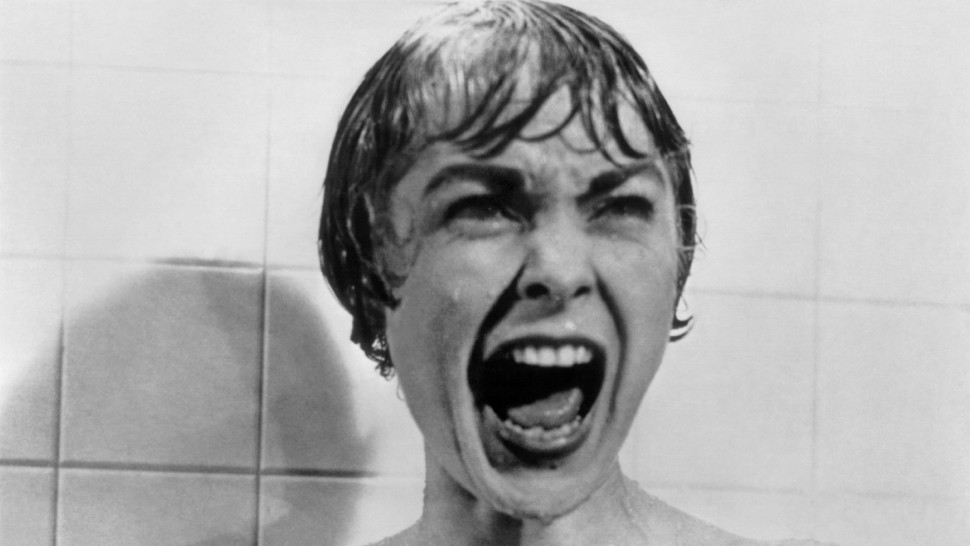

Many audiences of "Psycho" believe
the shower scene was extremely bloody and Janet Leigh was actually shown being
stabbed several times with blood flowing off her body. That is false and was
the fine editing work of the overlooked Film Editor George Tomasini.
In a 1964
interview Alfred Hitchcock stated:
As you know, you could not take the camera and just show a nude woman, it had to be done impressionistically. So, it was done with little pieces of film, the head, the feet, the hand, etc. In that scene there were 78 pieces of film in about 45 seconds.

The following link lets
my reader look at the above knife forward and backward. Showing it really never
touches the body.
On the link the screen is blank and
you need to click on it. What you will see is the use of shadows to create the
illusion of the blade touching the stomach as filmed by Cinematographer John L.
Russell.
The article I took the
above link from is entitled "8 frames of Psycho":
https://the.hitchcock.zone/onlyamovie/2008/05/08/8-frames-of-psycho/
https://the.hitchcock.zone/onlyamovie/2008/05/08/8-frames-of-psycho/
The blood was simply Hersey's Chocolate Syrup, plug, any one can buy at their local grocery store, but looking very realistic in the black and white footage.


Go to author Bill
Krohn's biography "Hitchcock at Work". In it his research
makes note that the shower scene was shot with two types of camera. One was an
industry standard the "BNC Mitchell", but the second was a hand held
"French Eclair", as Orson Welles used in "Touch of
Evil", to create montage images and severe close ups.
The following quote by Janet Leigh, from 1984, is part of an article for "Women's World" Magazine about
"Marion Crane" and that shower sequence:
https://www.womansworld.com/posts/janet-leigh-psycho-154863
Here’s a woman who had come to terms with what she had done,What I thought about was the inevitability of comeuppance. She was a victim of the time, the situation, her passion and, yet, her morality. It was really a very unconventional role, if you think about it. She was taking the shower and it was like a cleansing. She was going to go back and face the music. And to have that kind of ending was so against what the audience wanted or expected.
Which brings me to the
question:
Did Janet Leigh have a body double?
The answer depends upon
who you talk too. Leigh claimed its was her only in the shower. Others claim it
was partly Leigh and partly Pin Up Model Marli Renfro seen below. Alfred
Hitchcock first claimed it was only Janet Leigh, but in later interviews stated
that when you see Janet's face it is obviously her, but that otherwise it was
Renfro.

Whomever you believe. They are completely nude photo's of actress Janet Leigh, on the internet that take time locating, filming with Alfred Hitchcock that famous shower sequence.
"Marion Crane"
is dead, but what happens in Joseph Stefano's screenplay afterwards for the
next 85 minutes and 38 seconds?
First "Norman" discovers blood and finds "Marion's" body.
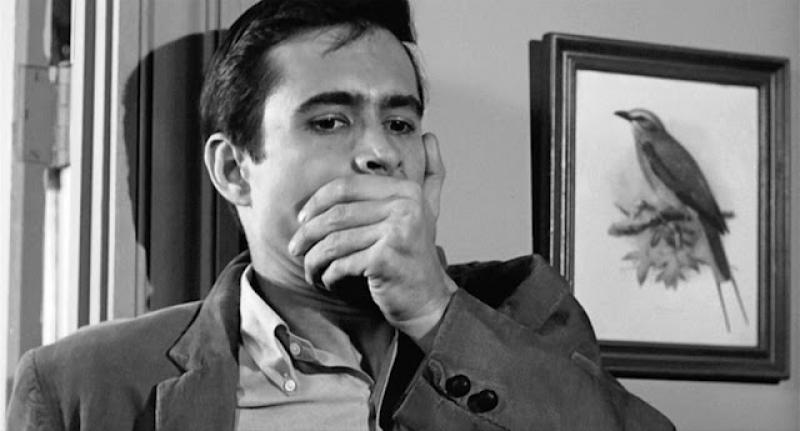
In panic knowing his "Mother" killed her. "Norman" takes "Marion's" body, her possessions including, unbeknownst to him the stolen money, and puts them in the trunk of her car. Then he drives the car into the convenient swamp next to the motel.

One week later "Marion's" sister "Lila Crane" shows up in Fairvale, California and confronts "Sam Loomis" about her sisters whereabouts. Private Investigator "Milton Arbogast" also shows up and speaks to the two confirming "Marion" is wanted for stealing the $40,000.

First "Norman" discovers blood and finds "Marion's" body.

In panic knowing his "Mother" killed her. "Norman" takes "Marion's" body, her possessions including, unbeknownst to him the stolen money, and puts them in the trunk of her car. Then he drives the car into the convenient swamp next to the motel.

One week later "Marion's" sister "Lila Crane" shows up in Fairvale, California and confronts "Sam Loomis" about her sisters whereabouts. Private Investigator "Milton Arbogast" also shows up and speaks to the two confirming "Marion" is wanted for stealing the $40,000.

"Arborgast" starts to investigate local hotels and motels between the
spot "Marion" traded cars and Fairvale. He does go to the "Bate's
Motel" and his suspicions are aroused that "Norman" may be hiding something, but leaves.

Next he calls "Lila" and "Sam" and informs them of his investigation to date.

"Arborgast" goes back to the "Bate's Motel" and can't locate "Norman". However, he notices what appears to be a women in the house and enters. "Milton Arbogast" then starts up the stairs in search of "Norman's" mother and is murdered by her.



Not having heard from "Arbogast". "Sam" leaves "Lila" and goes to the "Bate's Motel" and sees a figure in the motel that he assumes his "Norman's" mother, but she does not respond. "Sam" leaves and goes back to "Lila". The two visit "Deputy Sheriff Al Chambers" and relate their story. "Chambers" informs them that "Sam" couldn't have seen "Norman's" mother as she committed suicide 10 years ago. "Chambers" concludes "Arbogast" lied to "Sam" and "Lila" so he could pursue "Marion" and get the money for himself.

"Lila" and "Sam" go to the motel to speak to "Norman", but before they arrive. In an argument with his mother "Norman Bates" takes her down to the cellar for her protection.


No sure that something happened to "Marion" at the motel. "Sam" engages "Norman" in a conversation that allows "Lila" to sneak into the main house. Where she starts to search, but back at the motel "Norman" becomes agitated at "Sam" and manages to knock him out. He then heads for the house believing that "Lila Crane" is there.
In the house "Lila" enters the cellar and finds "Mrs. Bate's" sitting in a chair facing the opposite wall. "Lila" approaches the chair and turns "Mrs. Bates" around to find "Norman's" mother's mummified corpse. Suddenly "Norman" wearing his mother clothes attacks "Lila".


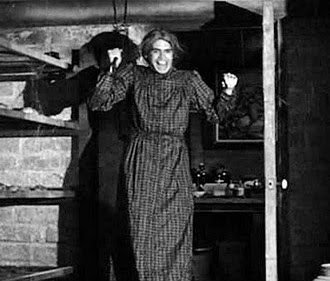
"Sam" has regained consciousness and stops "Norman".

At the courthouse a psychiatrist explains that 10 years ago "Norman" murdered his mother and her lover. He then dug up her body and assumed the alternate personality of his mother. "Norman" would dress in his mother's clothes and whenever he was attracted to a young women. His "Mother" would kill them. There had been two previous young women murdered, before "Marion Crane".
The film ends with "Norman" in his jail cell. While "Mother's" voice insists it was her son that did the murders. The audience next sees "Marion's" car being pulled from the swamp. Fade to closing credits.

Janet Leigh won the Golden Globe for Best Supporting Actress and was nominated for the Academy Award for Best Supporting Actress. Vera Miles, who was in the picture longer, was not nominated for any award for her performance. Anthony Perkins was only nominated for Best Actor by the International Board of Motion Pictures Reviewers. While Alfred Hitchcock was nominated for the Academy Award for Best Director and the Best Director Award by the Directors Guild of America. Hitch lost both nominations.

Next he calls "Lila" and "Sam" and informs them of his investigation to date.

"Arborgast" goes back to the "Bate's Motel" and can't locate "Norman". However, he notices what appears to be a women in the house and enters. "Milton Arbogast" then starts up the stairs in search of "Norman's" mother and is murdered by her.



Not having heard from "Arbogast". "Sam" leaves "Lila" and goes to the "Bate's Motel" and sees a figure in the motel that he assumes his "Norman's" mother, but she does not respond. "Sam" leaves and goes back to "Lila". The two visit "Deputy Sheriff Al Chambers" and relate their story. "Chambers" informs them that "Sam" couldn't have seen "Norman's" mother as she committed suicide 10 years ago. "Chambers" concludes "Arbogast" lied to "Sam" and "Lila" so he could pursue "Marion" and get the money for himself.

"Lila" and "Sam" go to the motel to speak to "Norman", but before they arrive. In an argument with his mother "Norman Bates" takes her down to the cellar for her protection.


No sure that something happened to "Marion" at the motel. "Sam" engages "Norman" in a conversation that allows "Lila" to sneak into the main house. Where she starts to search, but back at the motel "Norman" becomes agitated at "Sam" and manages to knock him out. He then heads for the house believing that "Lila Crane" is there.
In the house "Lila" enters the cellar and finds "Mrs. Bate's" sitting in a chair facing the opposite wall. "Lila" approaches the chair and turns "Mrs. Bates" around to find "Norman's" mother's mummified corpse. Suddenly "Norman" wearing his mother clothes attacks "Lila".



"Sam" has regained consciousness and stops "Norman".

At the courthouse a psychiatrist explains that 10 years ago "Norman" murdered his mother and her lover. He then dug up her body and assumed the alternate personality of his mother. "Norman" would dress in his mother's clothes and whenever he was attracted to a young women. His "Mother" would kill them. There had been two previous young women murdered, before "Marion Crane".
The film ends with "Norman" in his jail cell. While "Mother's" voice insists it was her son that did the murders. The audience next sees "Marion's" car being pulled from the swamp. Fade to closing credits.

Janet Leigh won the Golden Globe for Best Supporting Actress and was nominated for the Academy Award for Best Supporting Actress. Vera Miles, who was in the picture longer, was not nominated for any award for her performance. Anthony Perkins was only nominated for Best Actor by the International Board of Motion Pictures Reviewers. While Alfred Hitchcock was nominated for the Academy Award for Best Director and the Best Director Award by the Directors Guild of America. Hitch lost both nominations.
Janet Leigh's next screen appearance was as one of the 29 recognized "Hollywood"
personalities playing themselves in the 1960 motion picture "Pepe". The feature starred Mexican comedian Cantinflas, Mike Todd's 1956 "Around the World in 80 Days", Dan Daily and Shirley Jones. Then came a
major "Political Thriller".
THE MANCHURIAN CANDIDATE released October 24, 1962
"The Manchurian Candidate" was one of several "Cold War" motion pictures that fed off the fears of American's of a Communist take-over. It was based upon Richard Gondon's novel of the same name and was produced and director by John Frankenheimer.
Frankenheimer had directed 1962's "The Birdman of Alcatraz" starring Burt Lancaster and would go on to direct such films as 1964's "Seven Days in May" starring Lancaster and Kirk Douglas, "The Train" again with Lancaster that same year and the Horror Thriller "Seconds" starring Rock Hudson in 1966.
The screenplay was by George Axelrod. Axelrod, at this time, was known for four major "Hollywood" comedies. These were 1955's "The Seven Year Itch" starring Marilyn Monroe and Tom Ewell, 1957's "Will Success Spoil Rock Hunter" starring Tony Randall and Jane Mansfield, 1958's "Rally Round the Flag Boys" starring Paul Newman and Joanne Woodward and 1961's "Breakfast at Tiffany's" starring Audrey Hepburn and George Peppard. This screenplay was a major switch and George Axelrod nailed it.
The four main cast members in order of billing were:
Frank Sinatra as "Major Bennett Marco". 1960 was a big movie year for Frank Sinatra and included the musical "Can-Can" with songs by Cole Porter, the original "Ocean's 11" featuring his "Rat Pack" and the drama "The Devil at 4 O'clock" co-starring Spencer Tracy. Additionally in 1962 Frank was in a Western comedy based upon the movie "Gunga Din" co-starring "Rat Pack" member Dean Martin and Sammy Davis, Jr. "Sergeants Three".

Laurence Harvey was "Raymond Shaw". 1962 also saw Harvey in the drama "Walk on the Wild Side" co-starring Jane Fonda, Capucine and Anne Baxter, producer George Pal's Cinerama family film "The Wonderful World of the Brother Grimm" and another drama "A Girl Named Tamiko" co-starring France Nuyen.

"The Manchurian Candidate" was one of several "Cold War" motion pictures that fed off the fears of American's of a Communist take-over. It was based upon Richard Gondon's novel of the same name and was produced and director by John Frankenheimer.
Frankenheimer had directed 1962's "The Birdman of Alcatraz" starring Burt Lancaster and would go on to direct such films as 1964's "Seven Days in May" starring Lancaster and Kirk Douglas, "The Train" again with Lancaster that same year and the Horror Thriller "Seconds" starring Rock Hudson in 1966.
The screenplay was by George Axelrod. Axelrod, at this time, was known for four major "Hollywood" comedies. These were 1955's "The Seven Year Itch" starring Marilyn Monroe and Tom Ewell, 1957's "Will Success Spoil Rock Hunter" starring Tony Randall and Jane Mansfield, 1958's "Rally Round the Flag Boys" starring Paul Newman and Joanne Woodward and 1961's "Breakfast at Tiffany's" starring Audrey Hepburn and George Peppard. This screenplay was a major switch and George Axelrod nailed it.
The four main cast members in order of billing were:
Frank Sinatra as "Major Bennett Marco". 1960 was a big movie year for Frank Sinatra and included the musical "Can-Can" with songs by Cole Porter, the original "Ocean's 11" featuring his "Rat Pack" and the drama "The Devil at 4 O'clock" co-starring Spencer Tracy. Additionally in 1962 Frank was in a Western comedy based upon the movie "Gunga Din" co-starring "Rat Pack" member Dean Martin and Sammy Davis, Jr. "Sergeants Three".

Laurence Harvey was "Raymond Shaw". 1962 also saw Harvey in the drama "Walk on the Wild Side" co-starring Jane Fonda, Capucine and Anne Baxter, producer George Pal's Cinerama family film "The Wonderful World of the Brother Grimm" and another drama "A Girl Named Tamiko" co-starring France Nuyen.

Janet Leigh was "Eugenie Rose Chaney".

Angela Lansbury was "Mrs. Eleanor Shaw Iselin". The versatile Lansbury was 22 years away from the first of the 264 episodes of television's "Murder She Wrote". Earlier in 1962 the actress was part of the cast of John Frankenheimer's "All Fall Down" co-starring with Eva Marie Saint, Warren Beatty and Karl Malden. In 1962 she had co-starred with Elvis and Joan Blackman in "Blue Hawaii" and in 1960 was in the drama "The Dark at the Top of the Stairs" co-starring with Robert Preston, Dorothy McGuire and Eve Arden.

The two co-stars were:
Henry Silva as "Chunjin". Silva was known for playing tough guys in many motion picture genres. He had appeared in the 1957 Randolph Scott Western "The Tall T", the same years drug addiction drama "A Hatful of Rain" starring Eva Marie Saint and Don Murray and the following years Western "The Bravados" starring Gregory Peck. In 1959 he was in the romantic adventure "Green Mansions" starring Audrey Hepburn and Anthony Perkins and in 1960 was one of the Frank Sinatra's army buddies in "Ocean's 11".
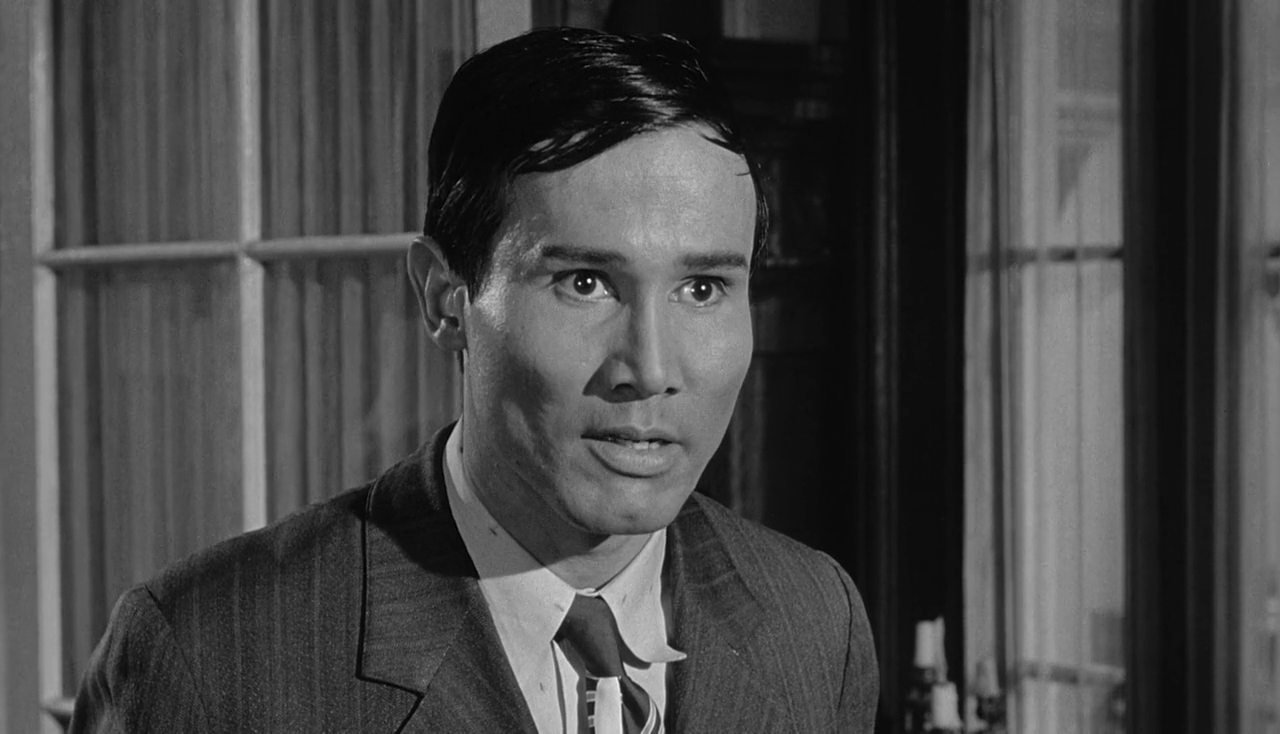
James Gregory was "Senator John Yerkes Iselin". Gregory's was primarily a television actor, but his motion pictures included portraying the Detective out to get "Al Capone" in the 1959 crime drama starring Rod Steiger. James Gregory was featured in 1963's "PT 109" starring Cliff Robertson as "John F. Kennedy", the same years "Captain Newman M.D." starring Gregory Peck, Tony Curtis and Angie Dickinson. He would become Dean Martin's boss in the "James Bond" inspired comedy spy films about "Matt Helm" and portray "General Urus" in 1970's "Beneath the Planet of the Apes". However, Gregory is probably best known as "Inspector Frank Luger" on television's "Barney Miller" from 1972 through 1982.

As with Alfred Hitchcock's "Psycho". The publicity for "The Manchurian Candidate" warned potential audiences about not entering the theater once the motion picture started. In the case of the Hitchcock film it was more a gimmick than anything else. As no movie theater owner was going to stop somebody buying a ticket and entering to see "Psycho" after the picture began.
However, in the case of "The Manchurian Candidate" the audience would be lost, if the opening credits for the film were on the screen. That opening sequence gave the one clue to what was being seen after those opening credits had ended.
The screenplay opens with a platoon of American soldiers during the Korean War being led by a South Korean soldier. Suddenly Chinese soldiers appear and capture them. Cut to three days later as "Captain Bennett Marco", "Staff Sergeant Raymond Shaw" and the others, minus two men, have escaped and made it back to United Nations lines. "Shaw" is awarded "The Medal of Honor" for saving their lives during combat on "Marco's" recommendation.
The Opening credits role.
The audience meets "Raymond Shaw's" mother who is using her son's notoriety to help promote her husband "Senator Iselin" career. The audience next finds "Major Marco" having a troubling recurring nightmare. Although the setting, sex and nationality of the characters will change. The actual events in the nightmare remain the same.

Now assigned to Army Intelligence "Bennett Marco" is seeing a V.A. Army psychiatrist about these nightmares.
In the seemingly real version of his nightmare. "Marco" describes, to the psychiatrist, seeing a Chinese doctor addressing a large group of assembled Communist military leaders and on either side of the doctor is his platoon.
In these nightmares "Shaw" is asked to take a pistol and kill one of the American soldiers. Which in a hypnotized state he does!

Angela Lansbury was "Mrs. Eleanor Shaw Iselin". The versatile Lansbury was 22 years away from the first of the 264 episodes of television's "Murder She Wrote". Earlier in 1962 the actress was part of the cast of John Frankenheimer's "All Fall Down" co-starring with Eva Marie Saint, Warren Beatty and Karl Malden. In 1962 she had co-starred with Elvis and Joan Blackman in "Blue Hawaii" and in 1960 was in the drama "The Dark at the Top of the Stairs" co-starring with Robert Preston, Dorothy McGuire and Eve Arden.

The two co-stars were:
Henry Silva as "Chunjin". Silva was known for playing tough guys in many motion picture genres. He had appeared in the 1957 Randolph Scott Western "The Tall T", the same years drug addiction drama "A Hatful of Rain" starring Eva Marie Saint and Don Murray and the following years Western "The Bravados" starring Gregory Peck. In 1959 he was in the romantic adventure "Green Mansions" starring Audrey Hepburn and Anthony Perkins and in 1960 was one of the Frank Sinatra's army buddies in "Ocean's 11".

James Gregory was "Senator John Yerkes Iselin". Gregory's was primarily a television actor, but his motion pictures included portraying the Detective out to get "Al Capone" in the 1959 crime drama starring Rod Steiger. James Gregory was featured in 1963's "PT 109" starring Cliff Robertson as "John F. Kennedy", the same years "Captain Newman M.D." starring Gregory Peck, Tony Curtis and Angie Dickinson. He would become Dean Martin's boss in the "James Bond" inspired comedy spy films about "Matt Helm" and portray "General Urus" in 1970's "Beneath the Planet of the Apes". However, Gregory is probably best known as "Inspector Frank Luger" on television's "Barney Miller" from 1972 through 1982.

As with Alfred Hitchcock's "Psycho". The publicity for "The Manchurian Candidate" warned potential audiences about not entering the theater once the motion picture started. In the case of the Hitchcock film it was more a gimmick than anything else. As no movie theater owner was going to stop somebody buying a ticket and entering to see "Psycho" after the picture began.
However, in the case of "The Manchurian Candidate" the audience would be lost, if the opening credits for the film were on the screen. That opening sequence gave the one clue to what was being seen after those opening credits had ended.
The screenplay opens with a platoon of American soldiers during the Korean War being led by a South Korean soldier. Suddenly Chinese soldiers appear and capture them. Cut to three days later as "Captain Bennett Marco", "Staff Sergeant Raymond Shaw" and the others, minus two men, have escaped and made it back to United Nations lines. "Shaw" is awarded "The Medal of Honor" for saving their lives during combat on "Marco's" recommendation.
The Opening credits role.
The audience meets "Raymond Shaw's" mother who is using her son's notoriety to help promote her husband "Senator Iselin" career. The audience next finds "Major Marco" having a troubling recurring nightmare. Although the setting, sex and nationality of the characters will change. The actual events in the nightmare remain the same.

Now assigned to Army Intelligence "Bennett Marco" is seeing a V.A. Army psychiatrist about these nightmares.
In the seemingly real version of his nightmare. "Marco" describes, to the psychiatrist, seeing a Chinese doctor addressing a large group of assembled Communist military leaders and on either side of the doctor is his platoon.
In these nightmares "Shaw" is asked to take a pistol and kill one of the American soldiers. Which in a hypnotized state he does!
When asked by both the Army psychiatrist and the head of Army Intelligence what
he thinks about "Raymond Shaw". "Marco" automatically
recites the same line:
Raymond Shaw is the kindest, bravest, warmest, most wonderful human being I've ever known in my life
Even though "Shaw" was
always a cold, unsympathetic loner in real life. Which bothers "Major
Marco" as to why he recommended him for "The Medal of Honor".
On a commuter train going into Washington D.C. "Bennett Marco" meets "Rose Chaney" and the two become close.
On a commuter train going into Washington D.C. "Bennett Marco" meets "Rose Chaney" and the two become close.


Although Leigh had billing over Lansbury. Her role is actually small, but important to the mental stability of Sinatra's character. Speaking of "mental stability".
Janet Leigh was about to leave her house to go and film the above scene at the studio. According to Jamie Lee Curtis, in a short "Turner Classic Movies" bio spot on her mother, Janet Leigh was served divorce papers from her then husband Tony Curtis as she walked out the front door.
Explaining to "Rose" what is
happening to him. "Marco" feels compelled even more to
find out what the dream is about and is their any reality too it? However, at
this point even the Army psychiatrist is not buying his belief that "Raymond
Shaw" is somehow tied to something else that happened in
Korea.
"Major Marco" then remembers there
is another soldier "Allen Melvin", played by James Edwards, near by
and he goes to him. "Marco" discovers "Melvin" is also
having what sounds like the exact same nightmare. He takes
"Melvin" to his Army Intelligence Supervisor "Colonel
Milt", played by Douglas Henderson", to tell him about his own
nightmares. Then when asked what "Allen Melvin" thinks of
"Raymond Shaw". The ex-soldier replies:
Raymond Shaw is the kindest, bravest, warmest, most wonderful human being I've ever known in my life.
The Army Intelligence
investigation is now on.
Meanwhile other events are occurring. "Raymond's" mother is guiding her husband's political career. By
turning "Senator Iselin" into a "Senator Eugene McCarthy" clone. "Raymond" has fallen in love with his next door neighbor "Senator Thomas Jordon's", played
by John McGiver, daughter "Jocelyn", played by Leslie Parish. The problem is "Senator Thomas" is a liberal rival to his step-father.
"Major Marco"
decides to visit "Shaw" and when he knocks on the door. The
"Iselin's" houseboy opens it. It is "Chunjin" the man who
was guiding "Marco's" platoon in Korea and actually a North Korean
agent. A fight between the two occurs and "Raymond Shaw" enters the room and breaks it up.


After leaving the "Iselin" residence "Marco" is met by "Rose". Seeing their "South Korean" guide he now starts to unravel what happened to the platoon and the source of his nightmares.



After leaving the "Iselin" residence "Marco" is met by "Rose". Seeing their "South Korean" guide he now starts to unravel what happened to the platoon and the source of his nightmares.

What is revealed is that
"Raymond Shaw" has been turned into a "Sleeper" agent of
the Chinese Communists, but why? "Major Marco" also figures out, from his
dream, that "Shaw" is triggered by the "Queen of Diamonds"
playing card, but who is his handler? It can't be the houseboy.


Later there is a costume party at "Senator
Iselin's" home and "Jocelyn Jordon" shows up as the "Queen
of Diamonds". This inadvertently triggers "Raymond Shaw's"
programming and he elopes with "Jocelyn". When his mother finds
out it is revealed that she is actually a Communist agent and her son's
handler. Now the real reason "Captain Marco's" platoon was captured
has been revealed. It was all part of a plan to brain wash "Raymond", make him a war hero a so his mother could control him, but too what purpose?

'Mrs. Iselin" uses the "Queen of Diamonds" playing card and has "Raymond" go over to "Senator Jordon's" home and murder him. "Jocelyn" comes in and "Raymond" murders her also.


The next day without a memory of what he did "Raymond Shaw" seems deeply disturbed,

'Mrs. Iselin" uses the "Queen of Diamonds" playing card and has "Raymond" go over to "Senator Jordon's" home and murder him. "Jocelyn" comes in and "Raymond" murders her also.


The next day without a memory of what he did "Raymond Shaw" seems deeply disturbed,
"The Why" has been revealed as "Mrs.
Iselin's" plans have progressed and her husband is now their party's Vice
Presidential candidate.
Things come to a head as
"Major Bennett Marco" meets "Raymond Shaw" with a "Forced Deck" of nothing but "Queen of Diamond" playing cards.
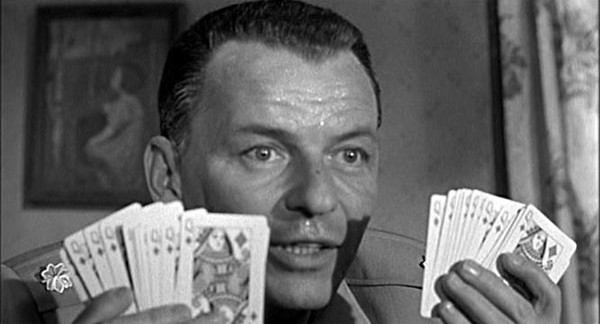


Using his "Forced
Deck" "Marco" attempts to free
"Shaw" of his mother's control, but has it worked? Next we see
"Mrs. Iselin" with the "Raymond" setting up the
assassination of the party's Presidential nominee at the Convention. Once he is
shot her husband, the Vice President nominee, becomes the new Presidential
nominee and "The Manchurian Candidate". Being
controlled by his loving wife and the Communist Party without his knowledge.
Because of the on air assassination "Senator Iselin" will promise, if
he's elected, in his wives words, he will seek "Emergency Presidential Power" that
will:
Make martial law seem like anarchy.
"Raymond" appears at
the convention dressed like a priest and is pass through the door. He goes to a
high point in what was a projection booth and takes out his sniper's rifle.
Meanwhile, "Marco" and "Milt" are rushing to the convention
to stop him.
"Shaw" is spotted and followed by "Marco", but the Major gets to the other just as the fires the rifle. However, instead of killing the Presidential nominee he kills "Senator Iselin" and his mother. Then as "Marco" watches "Shaw" turns the rifle on himself.



"Shaw" is spotted and followed by "Marco", but the Major gets to the other just as the fires the rifle. However, instead of killing the Presidential nominee he kills "Senator Iselin" and his mother. Then as "Marco" watches "Shaw" turns the rifle on himself.



According to rumor, but untrue. Democrat Frank Sinatra had the motion picture
removed from circulation after the November 22, 1963 assassination of his
friend President John Fitzgerald Kennedy. The rumor was untrue, according to my
Great Aunt Alice, a prominent member of the California Democratic Party and a
friend of both Sinatra and the President.
Angela Lansbury was nominated for the Academy Award for Best Supporting Actress, but did not win. She did win the Golden Globe for Best Supporting Actress. Ferris Webster was nominated for the Oscar for his film editing, but did not win.
I wrote an in depth look at "The Manchurian Candidate". Along with three other Cold War motion pictures and the novels they were based upon. My article "The Manchurian Candidate, Seven Days in May, Dr. Strangelove and Fail Safe: 1960's Cold War Paranoia in 2018" may be read at:
http://www.bewaretheblog.com/2018/09/the-manchurian-candidate-seven-days-in.html
Angela Lansbury was nominated for the Academy Award for Best Supporting Actress, but did not win. She did win the Golden Globe for Best Supporting Actress. Ferris Webster was nominated for the Oscar for his film editing, but did not win.
I wrote an in depth look at "The Manchurian Candidate". Along with three other Cold War motion pictures and the novels they were based upon. My article "The Manchurian Candidate, Seven Days in May, Dr. Strangelove and Fail Safe: 1960's Cold War Paranoia in 2018" may be read at:
http://www.bewaretheblog.com/2018/09/the-manchurian-candidate-seven-days-in.html
In the 18 years
between "The Manchurian Candidate" and "The
Fog". Janet Leigh appeared in over 40 different roles. Only 12
were motion pictures and the remaining guest appearances of television shows.
Among the 12 films was a 1972 very low budget Horror movie "The Night of the Lepus".
The real Horror being the Technicolor blood placed upon
cute Bunny Rabbits. That were either rear projected, or ran through H.O. models
of the town as giant mutated monsters attacking it. The film also featured hard up for acting gigs Stuart Whitman, Rory Calhoun and DeForest
Kelley.



THE FOG released February 8, 1980

"The Fog" is from the team of director, writer, composer John Carpenter and producer, writer Debra Hill. At this point the two had only made 1978's "Halloween" together. Although among Carpenter's other work was as the writer and director of the 1974 Science Fiction cult picture "Dark Star" and the original 1974 "Assault on Precinct 13".
The main cast in billing order were:
Adrienne Barbeau as "Radio Station Owner Stevie Wayne".
At this time she was married to John Carpenter. The actress had started acting
with the 1976's television movie "The Great Houdini" at 5th
billing. All her work prior to this picture was either on television shows such as "Maude" from 1972 through 1978,
or other made for television movies.


Jamie Lee Curtis was "Elizabeth Solley". Curtis started
her acting career in a 1977 episode of Jack Klugman's "Quincy
M.E." and from 1977 into 1978 co-starred on the television
version of the Cary Grant and her father Tony Curtis's 1959 motion picture "Operation
Petticoat". In 1978 Jamie Lee Curtis first appeared as
"Laurie" in Carpenter and Hill's original Horror classic "Halloween".
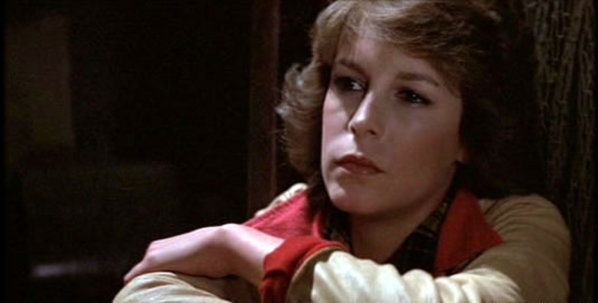

Janet Leigh was "Kathy Williams",


John Houseman was "Mr. Machen". Houseman was associated
with Orson Welles' "Mercury Theatre" and is credited with giving him
his first major role. Houseman worked with Welles on the 1938 "War of the
Worlds" broadcast to 1941's "Citizen
Kane". In 1973 John Houseman won the Academy Award for Best Actor
for the movie "The Paper Chase" as "Professor
Charles W. Kingsfield Jr", He did a reprise of the role for the
television series from 1978 through 1986.

Tom Atkins was "Nick Castle". Atkins was mainly a television actor since 1963. Prior to this film he had only been seen in two motion pictures. 17th billing in Frank Sinatra's 1968 "The Detective" and 20th billing in George Segal's 1970 "Where's Poppa?".

Although the cast listings have actor Hal Holbrook at 10th billing. The popular character actor's name is on the posters and other publicity for "The Fog" as "Father Malone". Stage actor Holbrook started film acting in one episode of the forgotten 1954 Daytime Soap Opera "The Brighter Day". He is known for his one man stage show "Mark Twain Tonight". That he began to develop in 1954 and in 1966 won the Tony Award for the one man show. The actor would win five Prime Time Emmy's for his work. Among his motion picture and television work prior to this feature are the motion picture "The Group" in 1966 and 1968's overlooked and very good teen take over of the United States Government "Wild in the Streets". On television he co-starred in the 1970-1971 series "The Bold Ones" and co-starred in the six episode mini-series "Abraham Lincoln" in the title role.

According to John Carpenter his inspiration for "The Fog" came from three motion pictures. The first was the 1958 British feature "The Trollenberg Terror". That movie was based upon the ITV mini-series of the same name from 1956. The movie Carpenter refers too came to the United States three months before it was seen in the U.K as "The Crawling Eye". The idea had unseen monsters hiding in a moving cloud killing people. The movie, like most British Science Fiction, is very good and has an intelligent screenplay.

Above the cloud that hide the monsters. Below what is in that cloud.

There was also a visit by John Carpenter and, his then girlfriend, Debra Hill to the British site of "Stonehenge" to promote his film "Assault on Precinct 13" in November 1977.
The second film related to the development of the story was the actual deliberate wrecking of a merchant ship off the California coast. Then plundering it in the early 1800's near the community of Goleta. The actual events were depicted in the 1975 motion picture "The Master Gunfighter" starring Tom "Billy Jack" Laughlin. The film is a confusing Samurai Western.
A third inspiration comes from a 1965 Italian Horror movie "5 Tombe per un Medium (5 Graves for a Medium)". Which came to the United States in 1967 as "Terror-Creatures form the Grave".
An Attorney arrives at a castle to settle the estate of the dead lord. Who has the power of raising long dead plague victims to kill a group of people in his castle. The movie co-starred American Barbara Steele of Mario Bava's 1960 "The Mask of Satan" aka: "Black Sunday" and Roger Corman's 1961 "The Pit and the Pendulum".
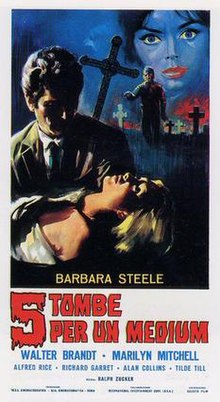
John Carpenter and Debra Hill's Screenplay
The story takes place in the fictional California town of Antonio Bay. The residents are excited to celebrate Antonio Bay's 100th Anniversary the following day. At 12:01 AM "Father Malone' is alone in his church when the first of several paranormal events occurs. A piece of masonry falls from one of the walls of the 100 year old church and the "Father finds his grandfather's journal in the wall.

Reading the journal "Malone" reads how in 1880 the six founders, his grandfather was one, of Antonio Bay deliberately sank a clipper ship the "Elizabeth Dane". The clipper was owned by "Blake", played by Rob Bottin, a wealthy man with leprosy. He wanted to establish a leper colony on the California coast and the ship carried a cargo of gold. Which was taken by the six founders to establish Antonio Bay and build the church.
Meanwhile, three Antonio Bay fisherman are off the coast when a mysterious fog appears. It engulfs the fishing trawler and within it appears the "Elizabeth Dane" and its dead crew.





The "Elizabeth Dane" pulls next to the fishing trawler and "Blake" starts his revenge with three murders.

While both events are going on "Nick Castle" is driving his truck toward his home in Antonio Bay and picks up hitchhiker "Elizabeth Solley".

As the two continue toward the town all the windows on "Nick's" truck shatter for no apparent reason. The next morning:
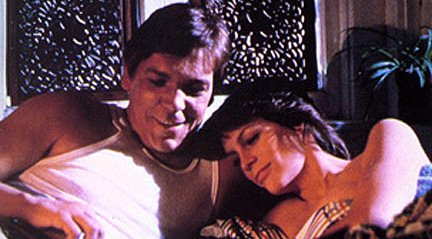
DJ "Stevie Wayne" is given a piece of driftwood by her son "Andy", played by Ty Mitchell. The he found on the beach that morning.Tom Atkins was "Nick Castle". Atkins was mainly a television actor since 1963. Prior to this film he had only been seen in two motion pictures. 17th billing in Frank Sinatra's 1968 "The Detective" and 20th billing in George Segal's 1970 "Where's Poppa?".

Although the cast listings have actor Hal Holbrook at 10th billing. The popular character actor's name is on the posters and other publicity for "The Fog" as "Father Malone". Stage actor Holbrook started film acting in one episode of the forgotten 1954 Daytime Soap Opera "The Brighter Day". He is known for his one man stage show "Mark Twain Tonight". That he began to develop in 1954 and in 1966 won the Tony Award for the one man show. The actor would win five Prime Time Emmy's for his work. Among his motion picture and television work prior to this feature are the motion picture "The Group" in 1966 and 1968's overlooked and very good teen take over of the United States Government "Wild in the Streets". On television he co-starred in the 1970-1971 series "The Bold Ones" and co-starred in the six episode mini-series "Abraham Lincoln" in the title role.

According to John Carpenter his inspiration for "The Fog" came from three motion pictures. The first was the 1958 British feature "The Trollenberg Terror". That movie was based upon the ITV mini-series of the same name from 1956. The movie Carpenter refers too came to the United States three months before it was seen in the U.K as "The Crawling Eye". The idea had unseen monsters hiding in a moving cloud killing people. The movie, like most British Science Fiction, is very good and has an intelligent screenplay.

Above the cloud that hide the monsters. Below what is in that cloud.

There was also a visit by John Carpenter and, his then girlfriend, Debra Hill to the British site of "Stonehenge" to promote his film "Assault on Precinct 13" in November 1977.
The second film related to the development of the story was the actual deliberate wrecking of a merchant ship off the California coast. Then plundering it in the early 1800's near the community of Goleta. The actual events were depicted in the 1975 motion picture "The Master Gunfighter" starring Tom "Billy Jack" Laughlin. The film is a confusing Samurai Western.
A third inspiration comes from a 1965 Italian Horror movie "5 Tombe per un Medium (5 Graves for a Medium)". Which came to the United States in 1967 as "Terror-Creatures form the Grave".
An Attorney arrives at a castle to settle the estate of the dead lord. Who has the power of raising long dead plague victims to kill a group of people in his castle. The movie co-starred American Barbara Steele of Mario Bava's 1960 "The Mask of Satan" aka: "Black Sunday" and Roger Corman's 1961 "The Pit and the Pendulum".

John Carpenter and Debra Hill's Screenplay
The story takes place in the fictional California town of Antonio Bay. The residents are excited to celebrate Antonio Bay's 100th Anniversary the following day. At 12:01 AM "Father Malone' is alone in his church when the first of several paranormal events occurs. A piece of masonry falls from one of the walls of the 100 year old church and the "Father finds his grandfather's journal in the wall.

Reading the journal "Malone" reads how in 1880 the six founders, his grandfather was one, of Antonio Bay deliberately sank a clipper ship the "Elizabeth Dane". The clipper was owned by "Blake", played by Rob Bottin, a wealthy man with leprosy. He wanted to establish a leper colony on the California coast and the ship carried a cargo of gold. Which was taken by the six founders to establish Antonio Bay and build the church.
Meanwhile, three Antonio Bay fisherman are off the coast when a mysterious fog appears. It engulfs the fishing trawler and within it appears the "Elizabeth Dane" and its dead crew.





The "Elizabeth Dane" pulls next to the fishing trawler and "Blake" starts his revenge with three murders.

While both events are going on "Nick Castle" is driving his truck toward his home in Antonio Bay and picks up hitchhiker "Elizabeth Solley".

As the two continue toward the town all the windows on "Nick's" truck shatter for no apparent reason. The next morning:


Written on the driftwood is the word "DANE". "Stevie" decides to take the driftwood to her radio station in the local lighthouse.

Inside the radio station "Stevie" turns on a tape recorder and it starts playing, She then puts the driftwood next to it.

The first thing that happens is water starts seeping from the driftwood. This results in her tape player short circuiting and that's followed by the voice of a strange man swearing revenge. Next the word "DANE" disappears from the drift wood and is replaced by "SIX MUST DIE" and the wet driftwood bursts into flames.

"Stevie" puts out the fire and sees the word "DANE" back on the driftwood and the tape returns to playing music normally.
"Nick" and "Elizabeth" hear about the missing fishing trawler and go out to locate it. They find it with "Dick Baxter", played by James Canning, inside with his eyes gouged out.
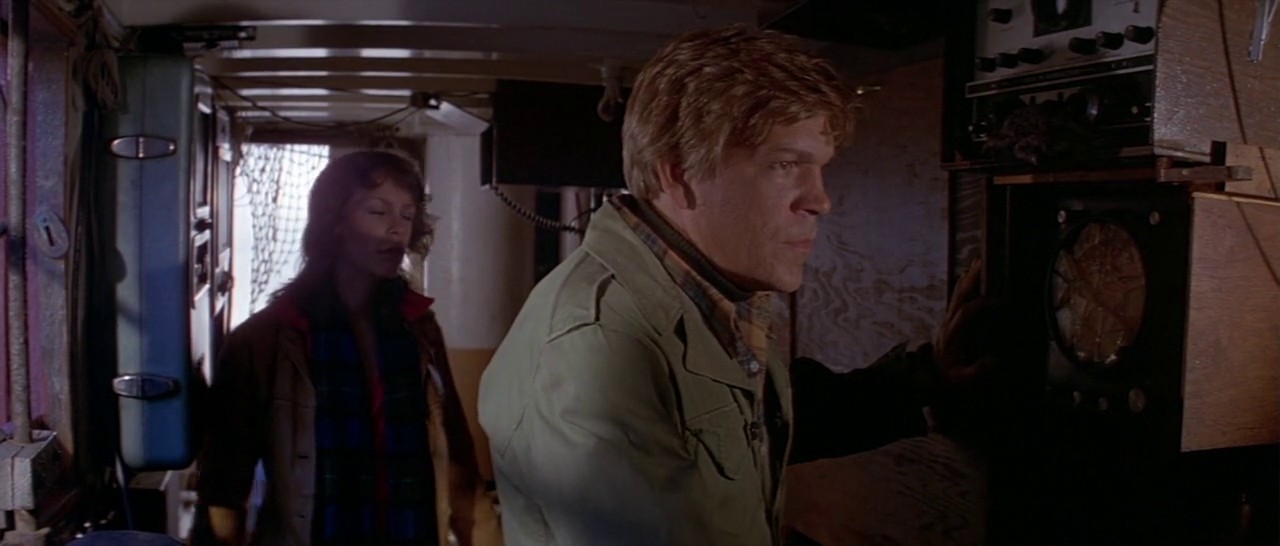
The other two fishermen are missing and one of them is the husband of "Kathy Williams". Who is organizing the 100 year centennial celebration. "Nick" and "Elizabeth" take "Dick Baxter's" body to the "Coroner Phibes", portrayed by Darwin Joston. A Horror fan can not overlook the fact that the coroner is "Dr. Phibes".

"Elizabeth" is left alone in the autopsy room with "Dick's" body on a table. While the two men talk about what might being going on.

Suddenly "Dick Baxter" comes to life, gets up and goes for "Elizabeth". She screams and "Nick" and "Dr. Phibes" re-enter the autopsy room. They find "Baxter's" body on the floor with the number "Three" carved upon it by some unknown force.
That night the 100 year celebration begins and at the lighthouse "Stevie" gets a call from local weatherman "Dan O'Bannon", played by Charles Cyphers, that a fog bank has mysteriously appeared and is heading for the town. She announces that fact over the airwaves. However, the phone hasn't been hung up and "Stevie" hears "Dan" answer a knock on his door and open it. In Horror "Stevie" listens to the slaughter of "Dan" by "Blake" and his crew,
The fog moves in and spreads into the town. "Stevie" fearful for "Andy" begs her listeners to go and save her son.


"Stevie" watches as "The Fog" nears her house from the lighthouse. Which has become surrounded by the fog and what might be in it.
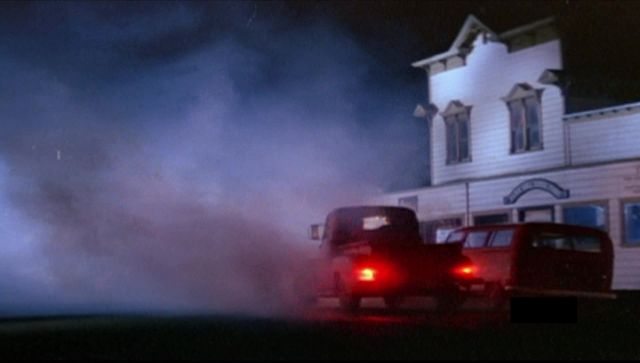
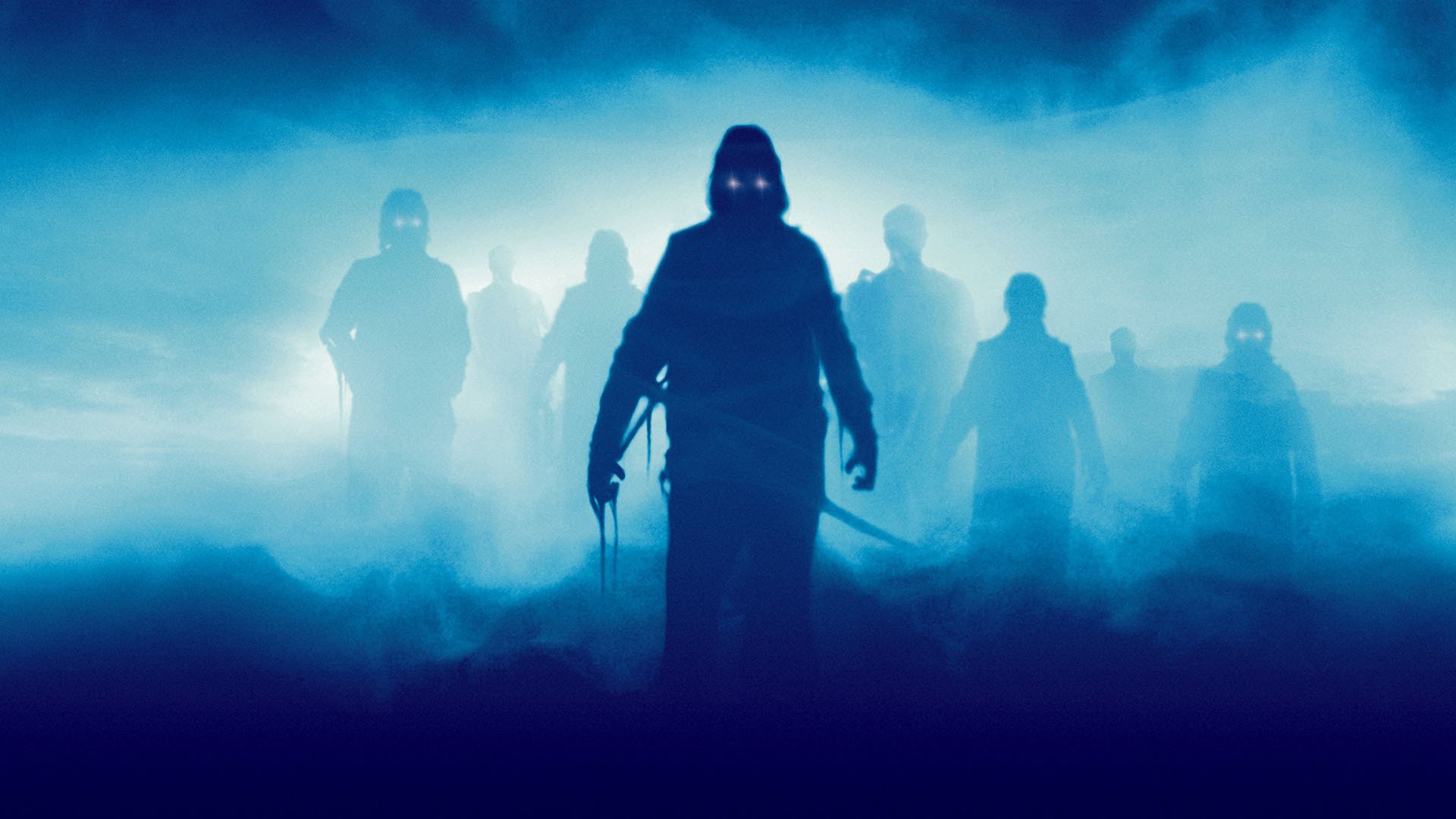
At "Stevie's" house the dead members of "Blake's" crew arrive and murder the babysitter "Mrs. Kobitz", played Regina Waldon, as "Nick" and "Elizabeth" arrive and he saves the "Andy".



From her lighthouse vantage point "Stevie" advises the residents of Antonio Bay to go to the church. There a group assembles with "Father Malone" and he explains his grandfather's journal and what is happening.

Above left to right in front, Tom Atkins as "Nick Castle", Hal Holbrook as "Father Malone", Janet Leigh as "Kathy Williams", Jamie Lee Curtis as "Elizabeth Solley" and Ty Mitchell as "Andy Wayne". In the back Nancy Loomis as "Sandy Fedel".

Outside of the church the dead crew continue to kill the citizens of Antonio Bay.
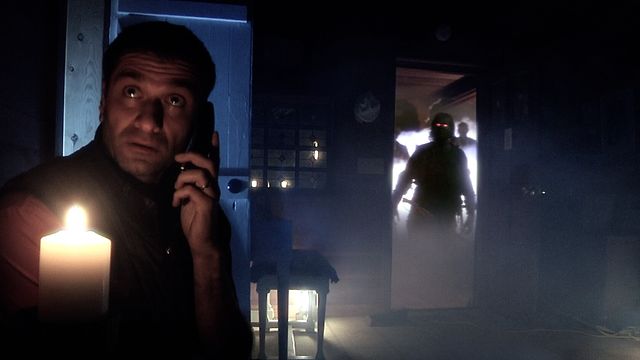
Back inside the church in the same wall cavity that "Father Malone" found his grandfather's journal a solid gold crucifix is discovered. "Malone" realizes that "Blake" and his crew have returned to take the lives of the descendants of original six founders. At the lighthouse "Stevie" is under attack and heads for the roof as members of "Blake's" crew attempt to kill her. Back at the church "Father Malone" makes a choice.


As the dead crew enter the church the Farther takes the solid gold cross into the main rectory.


"Blake" grabs the crucifix and it starts to glow. "Father Malone" is grabbed by "Nick Castle" pulling him to safety. As "Blake" and his crew disappear
At the lighthouse the dead crew also disappear and "Stevie Wayne" is left alone on the roof. The fog has completely disappeared from Antonio Bay and everyone else appears safe.
Alone in the church "Father Malone" wonders why he wasn't killed by "Blake" and having taken all the six descendants lives he wanted? The fog suddenly reappears inside the church and "Blake" and his crew with it. "Blake" decapitates "Father Malone" finalizing his revenge.

After "The Fog" Janet Leigh appeared in on 10 different television series. These included an episode of "Starman" entitled "Society's Pet", November 28, 1986, and the new "The Twilight Zone" in "Rendezvous in a Dark Place", March 11, 1989.
HALLOWEEN H20: 20 YEARS LATER released August 5, 1998

Based upon characters created by John Carpenter and Debra Hill. The screenplay takes the position that there were no other "Halloween" films after "Halloween II" released October 30, 1981 by Carpenter and Hill.
The film is from a story by Robert Zappia and an non screen credited Kevin Williamson. Both are television writers, but whereas Zappia had written mostly for animated children shows like "Tom and Jerry". Williamson wrote Horror movies such as 1997's "I Know What You Did Last Summer" and would write for "The Vampire Diaries" television series.
The screenplay was by Zappia and Matt Greenberg. Greenberg had already written the screenplays for 1995's "Children of the Corn III: Urban Harvest" and 1998's "The Prophecy II".
The motion picture was directed by Steve Miner. He started out by directing 1981's "Friday the 13th: Part 2" and 1983's "Friday the 13th: Part III". In 1985 Miner directed the Horror film "House" and strangely followed that in 1988 by directing 9 episodes of television's "The Wonder Years". Steve Miner would direct the 1989 Horror film "Warlock" and 9 of the 13 episodes of the television mini-series "Elvis".
Main cast as billed:
Jamie Lee Curtis was once more "Laurie Strode", but this time aka: "Keri Tate". Between "The Fog" and this film Curtis had 37 different roles split between television and motion pictures. Her voice is heard, but she's not seen in John Carpenter's 1981 "Escape from New York", or seen in 1982's "Halloween III: Season of the Witch". She played "Buckaroo Banzai's mother" in 1984's "The Adventures of Buckaroo Banzai Across the 8th Dimension", but all her scenes were deleted prior to release. She was "Wanda Gershwitz" in the classic 1988 comedy motion picture "A Fish Called Wanda" and starred as "Hannah Miller" in the 56 episode, 1989-1992, television series "Anything But Love", but she kept returning to "Halloween".

Adam Arkin was "Will Brennan". Arkin was familiar to television audiences. Prior to this picture he appeared as a regular on these television series: 1977's "Busting Loose", 1986's "A Year in the Life", 1989's "Knot's Landing", 1991's "China Beach", 1990's "Northern Exposure" and 1994's "Picket Fences".

Michelle Williams was "Molly Cartwell"". Williams was the young "Sil" in 1995's "Species" and another teen in the same years "Timemaster". Also in 1998 she became "Jen Lindley" for the 128 episode run of "Dawson's Creek".

Adam Hann-Byrd was "Charlie Deveraux"". Hann-Byrd started movie acting with 1991's "Little Man Tate". In the title role of that Jody Foster directed and starring picture. He portrayed the young version of Robin Williams in 1995's "Jumanji" and appeared in the 1996 American remake of the classic 1955 French film "Diabolique" that starred Sharon Stone.

Jodi Lyn O'Keefe was "Sarah Wainthrope". O'Keefe was "Maggie Cory" in the continuing daytime soap opera "Another World". In 1996 she started to appear in the first of 122 episodes of the Don Johnson and Cheech Marin television series "Nash Bridges" as "Cassidy Bridges" and during that run made this feature and 2000's "The Crow: Salvation".

Janet Leigh was "Norma". This was a small role in the film, but of course the gimmick was to have "Psycho" mother with "Halloween" daughter in the same motion picture as seen below. There's more too it so read on.

Josh Hartnett was "John Tate". This was Hartnett's first on screen appearance and he followed it in 1998 with the Science Fiction "The Faculty".

LL Cool J was Security Guard "Ronny". Technically LL Cool J was acting since 1984, but mainly in music videos. His first actual feature film was 1991's "The Hard Way" starring Michael J. Fox and James Woods. He had 7th billing as "Billy". In 1998 LL Cool J started to appear in motion pictures and had perfected his acting style with the movie "Caught Up". In 2009 he guest starred as "Sam Hanna" in a two part episode of television's "NCIS" and the same year became a regular on the spin off "NCIS: Los Angeles".
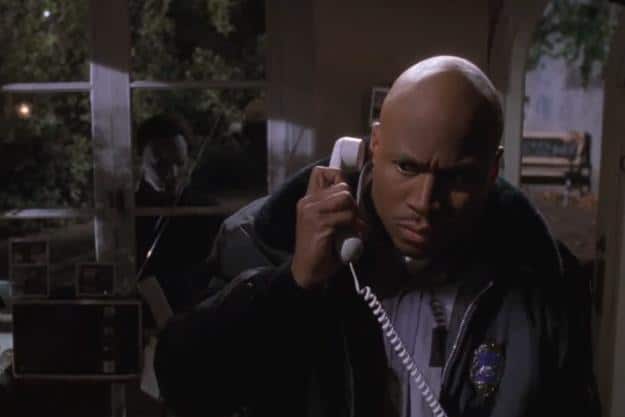
One last actor to mention and that's stunt man Chris Durand. You won't see his face, because he plays "Michael Myers". So here he is below. One interesting piece of trivia. Durand had never seen any of the previous "Halloween" franchise, before he took the role of "Michael" in this picture.

Before I go into the actual plot for "Halloween H20: 20 Years Later". I said there was more to the mother and daughter appearances in this feature. The small role of "Norma" as the secretary of "Keri Tate", the Head Mistress of the "Hillcrest Academy", is filled with a little inside joking by Kevin Williams and director Steve Miner.
In Janet Leigh's final scene in the movie. "Norma" is leaving the school in the following car.

A classic for an older women to be driving, but does it look familiar? It's the same model car "Marion Crane" drove to the "Bate's Motel" and it has a copy of the exact license plate on the car dumped into the swamp by "NORMAN Bates", or is that "Norma"? As the female version of "Norman" is used for Leigh's character.
Additionally as Janet Leigh walks to "Norma's" car. The audience hears the theme from 1960's "Psycho". There's another "Psycho" reference in this motion picture that actually goes back to the original John Carpenter and Debra Hill 1978 "Halloween". This is almost always overlooked. Psychiatrist "Dr. Sam Loomis" was named for "Marion Crane's" lover "Sam Loomis",

"Halloween H20: 20 Years Later" is a direct sequel to John Carpenter and Debra Hill's original 1981 "Halloween II". The screenplay recreates that pictures ending on October 29, 1978. The same date their original "Halloween" ended upon. The date of "H20" is October 29, 1998, or 20 years later.
Confusion Alert:
First shown at the Toronto, Canada, film festival on September 8, 2018 was director David Gordon Green's "Halloween". That motion picture is a direct sequel not to 1981, but to Carpenter and Hill's original 1978 "Halloween". The film opens with "Michael Myers" falling off the balcony at the ending of the 1978 original, but proceeds forward with a different story line, As that screenplay switches to October 29, 2018, or 40 years later than October 29, 1978. Jamie Lee Curtis is again "Laurie Strode" in this film and instead of a son. "Laurie" has a daughter named "Karen" played by Judy Greer.

Above Jamie Lee Curtis and Judy Greer in 2018 "Halloween".
Returning to "Halloween H20: 20 Years Later".
Now the previously thought missing"Michael Myers" from the "Halloween II" is seen burglarizing the Langdon, Illinois, retirement home of the late "Dr. Sam Loomis". Arriving at the home is "Nurse Marion Chambers", played by Nancy Stephens in both "Halloween" and "Halloween II". She took care of the doctor until his death.

Looking over things "Marion", interesting first name going back to the original Carpenter and Hill picture, discovers the file on "Laurie Strode" is missing. Again, referencing "Halloween II", "Laurie" was presumed killed in an automobile accident. "Michael" kills "Marion" and her teenage neighbor "Jimmy" and his friend "Tony", before leaving the house with "Laurie's" file.
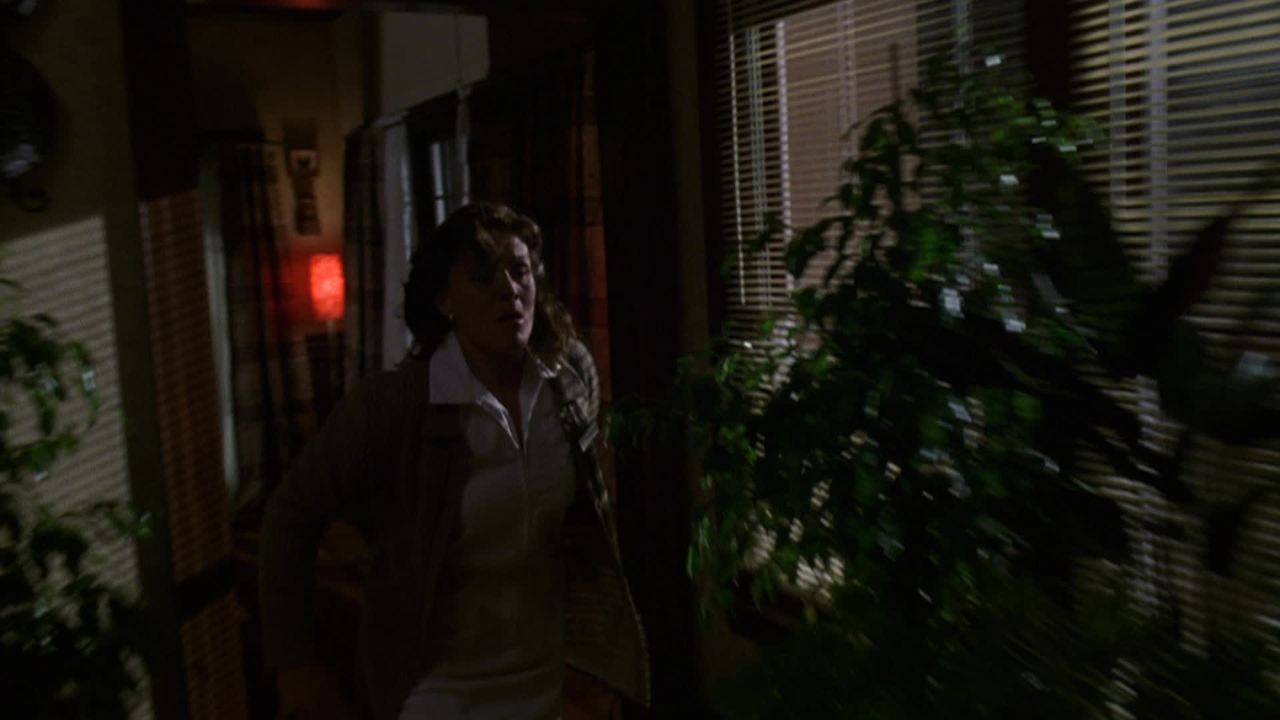
Switch to Summer Glen, California, and "Laurie" living under the assumed name of "Keri Tate". She is now the Head Mistress of the Hillcrest Academy. "Keri/Laurie" is still haunted by a fear that "Michael" might still return.

There is a major school trip to Yosemite National Park. All the students and faculty leave for the trip EXCEPT "Keri", "Will", school guard "Ronny" and of course "Laurie/Keri's" son "John, his girlfriend "Molly" and their two friends "Charlie" and "Sarah". A convenient plot device to greet "Michael's" arrival. The reason the four students are still at school is explained that they're having a "Halloween Party" in the school basement. Look for a "Hockey Mask" thrown in by director Miner as an inside joke to his "Friday the 13th" movies and "Jason Voorhees".
Later that night "Keri" reveals her true identity to "Will". While "Michael" shows up and murders "Charlie" and "Sarah".

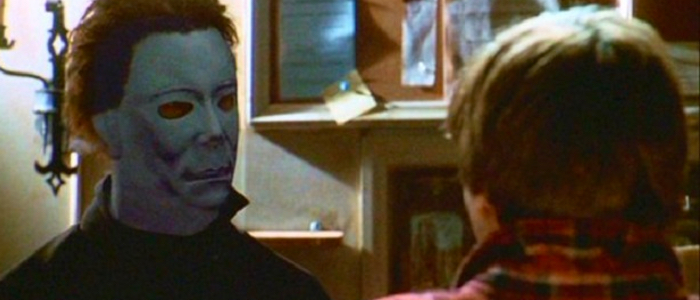

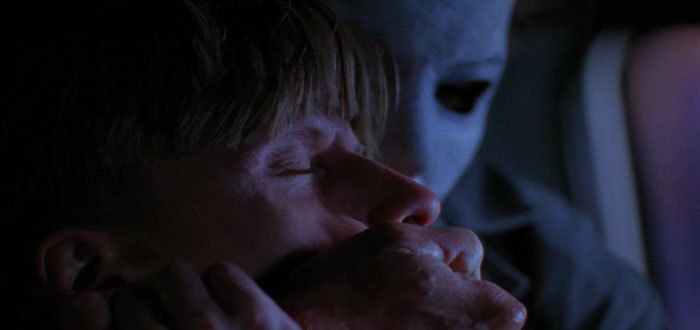
"John" and "Molly" are now chased by "Michael" across the school grounds.

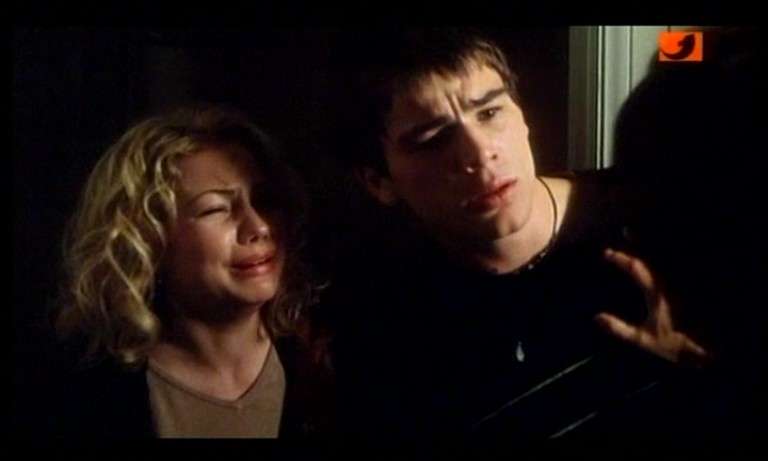
"Will" and "Laurie" arrive in time to help her son and "Molly".

"Laurie" now comes face to face with "Michael" for the first time in 20 years.

In the confusion that follows "Will" accidentally shoots "Ronny". Who was patrolling the halls, but "Michael" also kills "Will".


"Laurie" manages to get "John" and "Molly" to safety and now comes the climatic battle between her and "Michael", or at least in this picture.

"Laurie" stabs "Michael" multiple times and pushes him off a balcony. On the ground "Laurie" prepares to stab "Michael" again, but "Ronny", who survived "Will's" shooting, convinces her not too. The police and coroner arrive and "Michael's" dead (?) body is loaded into the van.
"Laurie" next steals the van with the body in it and is being pursued by the police. "Michael", who of course in not dead, attacks her. "Laurie" slams on the brakes sending "Michael" through the front windshield and goes down a steep hill. As the van goes down the hill "Laurie" tumbles out and it comes to rest pinning "Michael" between it and a fence post.
"Laurie Strode" now takes an ax and decapitates "Michael Myers".

Janet Leigh passed away on October 3, 2004 in Beverly Hills, California. Although over her career she was seen in 84 different roles. She will always be "Marion Crane" in the original "Psycho" even though she was only it for 23 minutes and 22 seconds.








No comments:
Post a Comment